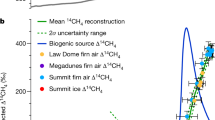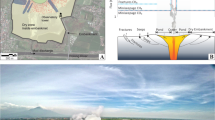Abstract
In 1972 average mixing ratio of methane in the troposphere was 1.41 ppm and 1.3 ppmv for the northern and southern hemisphere, respectively, which corresponds to a total amount of 4×1015 g of CH4 present in the atmosphere. Most is of recent biologic origin.14C analyses show that no more than 20 percent is released by fossil sources. The various ecosystems producing CH4 are discussed and the total annual production is estimated to lie between 5.5×1014 g/yr and 11×1014 g/yr. The corresponding turnover times for atmospheric CH4 range from 4 to 7 yrs. The destruction of CH4 takes place mainly in the troposphere, most probably through the reaction of CH4 + OH ↠ CH3 + H2O. About 10 percent of the CH4 is destroyed in the stratosphere. The CH4 cycle contributes on the order of 1 percent to the atmospheric carbon cycle.
Similar content being viewed by others
References
Bainbridge, A. E., Suess, H. E. andFriedman, I. (1961),Isotopic composition of atmospheric hydrogen and methane, Nature192, 648–649.
Baker-Blocker, A., Donahue, T. M. andMancy, K. H. (1977),Methane flux from wetlands areas, Tellus29, 245–250.
Benoit, R. (1973), Private communications.
Bishop, K. F., Delafield, H. I., Eggleton, A. E. J., Peabody, C. O. andTaylor, B. T. (1962),The tritium content of atmospheric methane, Proc. Sym. Tritium Phys. Biol. Sci., Vienna, Austria, May 3–10, 1961, Vol. 1, p. 55.
Broecker, W. S. andPeng, T. H. (1974),Gas exchange rates between air and sea, Tellus26, 21–35.
Conger, P. S. (1943),Ebullition of gases from marsh and lake waters, Pub.59, Cheasapeake Biol. Lab. Solomons Island, Maryland, U.S.A., pp. 1–42.
Crutzen, P. (1974),Photochemical reactions initiated by and influencing ozone in unpolluted tropospheric air, Tellus26, 47–57.
Davis, D. D., Heaps, W. andMcGee, T. (1976),Direct measurements of natural tropospheric levels of OH via an airborne tunable dye laser, Geophys. Res. Letters3, 331–333.
Ehhalt, D. H. andHeidt, L. E. (1973), Vertical profiles ofCH 4 in the troposphere and stratosphere, J. Geophys. Res.78, 5265–5271.
Ehhalt, D. H. (1974),The Atmospheric Cycle of Methane, Tellus26, 58–70.
Ehhalt, D. H.,The Atmospheric Cycle of Methane, in:Microbial Production and Utilization of Gases (H. G. Schlegel, G. Gottschalk, N. Pfennig, eds.), (E. Goltze KG, Göttingen, 1976), pp. 13–22.
Ehhalt, D. H. (1977),The CH4 concentration over the ocean and its possible variation with latitude, Tellus, in press.
Fink, U., Rank, D. H. andWiggins, T. Q. (1965),Abundance of methane in the earth's atmosphere, Techn. Rept. on Office of Naval Research Contract NONR-656 (12), NR 014-401, Penn. State University, University Park, Pennsylvania, U.S.A.
Greiner, N. R. (1970),Hydroxyl radical kinetics by kinetic spectroscopy, VI. Reactions with alkanes in the range 300–500 K, J. Chem. Phys.53, 1070–1076.
Heidt, L. E. andPollock, W. H. (1976),Measurements of N2O, CH4, H2, COand CO2 in the non urban troposphere. Proceedings Symp. on ‘The Non-Urban Tropospheric Compsition’ Hollywood, Florida, U.S.A.
Hitchcock, D. R. andWechsler, A. E. (1972),Biological cycling of atmospheric trace gases, Final rept, NASW-2128, 117–154.
Howard, D. L., Frea, J. I. andPfister, P. M. (1971),The potential for methanecarbon cycling in Lake Erie, Proc. 14th Conf. Great Lakes Res. Int. Assoc., Great Lakes Research, pp. 236–240.
Hutchinson, G. E. (1948),Circular casual systems in ecology, Ann. New York Acad. Sci.50, 221.
Hutchinson, G. E.,The biochemistry of the terrestrial atmosphere. In:The Solar System; II. The Earth as a Planet (G. P. Kniper, ed), (Chicago Press, 1954), pp. 371–433.
Hutchinson, G. E.,A Treatise on Limnology (New York, John Wiley, 1957), pp. 631–632.
Koyama, T. (1963),Gaseous metabolism in lake sediments and paddy soils and the production of atmospheric methane and hydrogen, J. Geophys. Res.68, 3971–3973.
Koyama, T.,Biogeochemical studies on lake sediments and paddy soils and the production of atmospheric methane and hydrogen, In:Recent Researches in the Field of Hydrosphere, Atmosphere and Nuclear Geochemistry (Y. Miyake and T. Koyama, eds.), (Marucen, Tokyo, 1964), pp. 143–177.
Lamontagne, R. A., Swinnerton, J. W., Linnenbom, V. J. andSmith, W. D. (1973),Methane concentrations in various marine environments, J. Geophys. Res.78, 5317–5324.
Lamontagne, R. A., Swinnerton, J. W. andLinnenbom, V. J. (1974), C1−C4 hydrocarbons in the north and south pacific, Tellus26, 71–77.
Levy, H. (1971),Normal atmosphere: large radical and formaldehyde concentrations predicted, Science173, 141–143.
Libby, W. F. (1973), Private communication.
Liss, P. S. andSlater, P. G. (1974),Flux of gases across the air-sea interface, Nature247, 181–184.
McConnell, J. C., McElroy, M. B. andWofsy, S. C. (1971),Natural sources of atmospheric CO, Nature223, 187–188.
Migeotte, M. V. (1948),Spectroscopic evidence of methane in the earth's atmosphere, Phys. Rev.73, 519–520.
Perner, D., Ehhalt, D. H., Pätz, H. W., Platt, U., Röth, E. P. andVolz, A. (1976),OH-radicals in the lower troposphere, Geophys. Res. Letters3, 466–468.
Rossolimo, L. (1935),Die Bodengasausscheidung und das Sauerstoffregime der Seen, Verh. Int. Ver. Limnol,7, 539–561.
Seiler, W. andSchmidt, U.,Dissolved nonconservative gases in seawater, in:The Sea, Vol. V (E. D. Goldberg, ed.), (Wiley, New York, 1974), pp. 219–243.
Svensson, B. H. (1973),Production of Methane and Carbon Dioxide from a subarctic Mire, Tech. Rep. 16 Swedish Tundra Biome Project.
Svensson, B. H., Veum, A. K. andKjelvik, S.,Carbon losses from Tundra Soils, in:Ecological Studies. Analysis and Synthesis, 16 (F. E. Wielgolaski, ed.), (Springer Verlag, Berlin, Heidelberg, New York, 1975).
Sverdrup, H. U., Johnson, M. W. andFleming, R. H. (1961),The Oceans, their Physics, Chemistry and General Biology (Prentice Hall, Englewood Cliffs, N.J., 1961), p. 21.
Swinnerton, J. W. andLinnenbom, V. J. (1967),Gaseous hydrocarbons in sea water: determination, Science156, 119–120.
Swinnerton, J. W., Linnenbom, V. J. andCheck, C. H. (1969),Distribution of methane and carbon monoxide between the atmosphere and natural waters, Environ. Sci. Tech.3, 836.
Twenhofel, W. H.,Principles of Sedimentation (McGraw-Hill, New York, 1951), p. 78.
United Nations Food and Agricultural Organization (1971a), Monthly Bulletin of Agricultural Economics and Statistics,20: 6, 18.
United Nations Food and Agricultural Organization (1971b), Monthly Bulletin of Agricultural Economics and Statistics,20: 9, 20.
United Nations Food and Agricultural Organization (1970),Production Yearbook, p. 335.
United States Department of Agriculture (1971),Agricultural Statistics, Washington, D.C., Government Printing Office.
Volz, A., Ehhalt, D. H., Heidt, L. E. andPollock, W. (1976),Vertical profiles of CH4, COand CO2 in the stratosphere, Proc. Joint Symposium on Atmospheric Ozone (IAOC/ICACGP), Dresden, GDR.
Wang, C. C., Davis, L. I., Wu, C. H. andJapar, S. (1976),Laser-induced dissociation of ozone and resonance fluorescence of OH in ambient air, Appl. Phys. Letters28, 14–16.
Warneck, P. (1975),OH production rates in the troposphere, Planet. Space Sci.23, 1507–1518.
Whittaker, R. H. (1971),Communities and Ecosystems, New York, The MacMillan Company, p. 84.
Wofsy, S. C. (1976), Interactions ofCH 4 andCO in the Earth's atmosphere, Atm. Rev. Earth Planet. Sci.4, 441–469.
Woodwell, G. M. (1970),The energy cycle of the biosphere, Sci. Am.223, 64–74.
Yamamoto, S., Alcauskas, J. B. andCrozier, T. E. (1976),Solubility of methane in distilled water and seawater, J. Chem. Eng. Data21, 78–80.
Author information
Authors and Affiliations
Rights and permissions
About this article
Cite this article
Ehhalt, D.H., Schmidt, U. Sources and sinks of atmospheric methane. PAGEOPH 116, 452–464 (1978). https://doi.org/10.1007/BF01636899
Received:
Issue Date:
DOI: https://doi.org/10.1007/BF01636899




